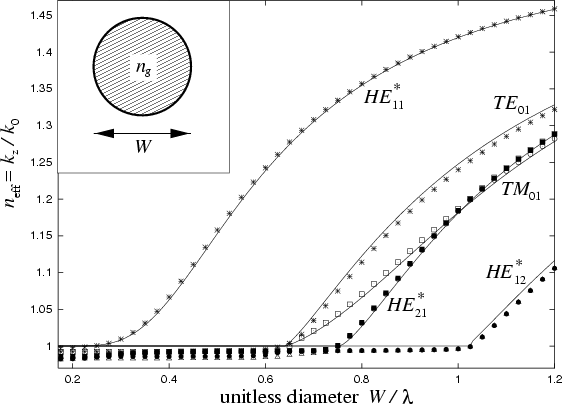In this section we present calculations, performed using the method
of Section 8.4, for a practical
substrate choice
of sodium fluoride (the lowest refractive index common mineral, with
![]() at a wavelength of 852nm), and investigate how this
changes the atom waveguide properties from those presented above.
We increased
at a wavelength of 852nm), and investigate how this
changes the atom waveguide properties from those presented above.
We increased ![]() to 1.7 (dense flint glass, e.g. BaSF type)
in order to provide
sufficient index difference from the substrate.
to 1.7 (dense flint glass, e.g. BaSF type)
in order to provide
sufficient index difference from the substrate.
Fixing the width at
![]() , we found that a height
, we found that a height
![]() gave the largest
gave the largest ![]() of
of ![]() , and allowed both modes to be
sufficiently far from cut-off (greater than half the power being carried inside
the guide for both modes).
The result is a goodness factor
, and allowed both modes to be
sufficiently far from cut-off (greater than half the power being carried inside
the guide for both modes).
The result is a goodness factor ![]() which is approximately half that of the
which is approximately half that of the
![]() case, with a
corresponding halving of the achievable product of depth and
coherence time according to (8.11), and doubling of the
heating rate at a given
case, with a
corresponding halving of the achievable product of depth and
coherence time according to (8.11), and doubling of the
heating rate at a given ![]() and
and ![]() according to
(8.13).
The shorter decay lengths of 56nm and 68nm (compared to 93nm and 137nm
for
according to
(8.13).
The shorter decay lengths of 56nm and 68nm (compared to 93nm and 137nm
for ![]() ) cause the typical trapping distance
) cause the typical trapping distance ![]() to be
reduced by a factor of roughly 1.8.
to be
reduced by a factor of roughly 1.8.
We found that in order to reproduce the depth of ![]() K
and
K
and
![]() m of the upper trap of Figure 8.3
(with
m of the upper trap of Figure 8.3
(with ![]() unchanged) we needed
unchanged) we needed
![]() mW, giving
mW, giving
![]() ms.
The large power increase over the 1mW required for
ms.
The large power increase over the 1mW required for ![]() is explained by the fact that this
is explained by the fact that this ![]() is now towards the upper
limit practically achievable rather than the lower.
(If
is now towards the upper
limit practically achievable rather than the lower.
(If ![]() is instead scaled in proportion to the new decay lengths,
the required increase in
is instead scaled in proportion to the new decay lengths,
the required increase in ![]() is only a factor 1.7).
In this example, we find the transverse oscillation frequencies have
increased to
is only a factor 1.7).
In this example, we find the transverse oscillation frequencies have
increased to
![]() kHz and
kHz and
![]() kHz, compared to the original
kHz, compared to the original
![]() kHz and
kHz and
![]() kHz.
The increase in
kHz.
The increase in ![]() is explained entirely by the shorter decay lengths,
and the increase in
is explained entirely by the shorter decay lengths,
and the increase in ![]() (by a factor of over 3) is attributed to tighter
optical mode shapes.
It is clear that this latter effect outweighs the decrease in
(by a factor of over 3) is attributed to tighter
optical mode shapes.
It is clear that this latter effect outweighs the decrease in
![]() ,
implying that the inclusion of the substrate has
actually increased
,
implying that the inclusion of the substrate has
actually increased ![]() by 50%.
by 50%.
In summary, the
effects of including a realistic substrate limit the maximum trapping
distance ![]() that can be achieved (because of the reduction in decay lengths),
lower the goodness factor, increase the heating rate and the
required optical power, but also
increase the oscillation frequencies.
For our substrate choice, each of these changes was approximately
a factor of 2, and we believe that they do not alter the basic practicality
of implementing our proposed waveguide.
that can be achieved (because of the reduction in decay lengths),
lower the goodness factor, increase the heating rate and the
required optical power, but also
increase the oscillation frequencies.
For our substrate choice, each of these changes was approximately
a factor of 2, and we believe that they do not alter the basic practicality
of implementing our proposed waveguide.
 |